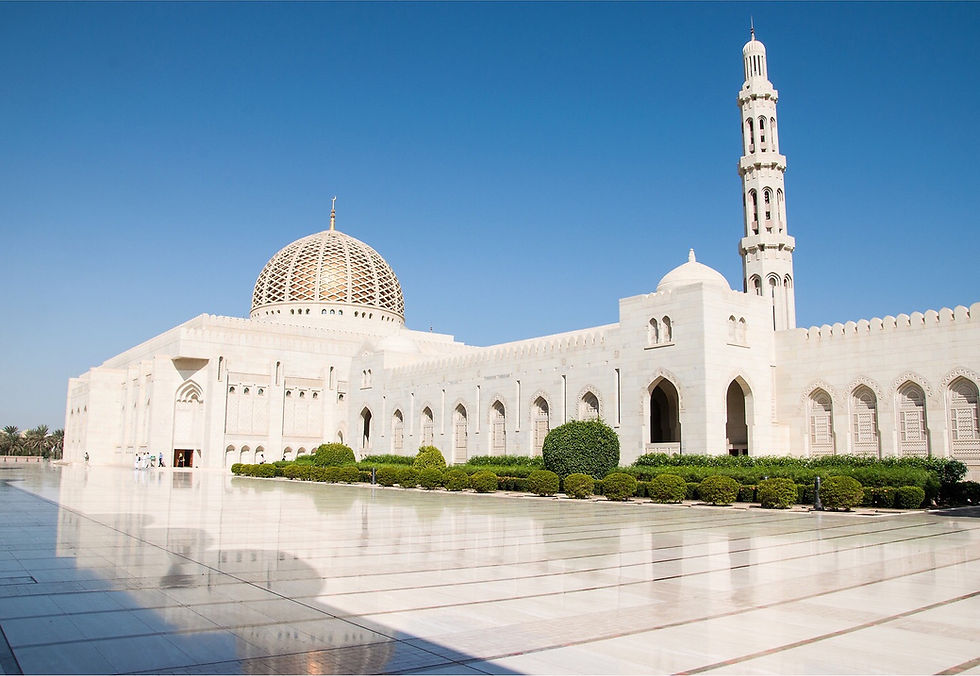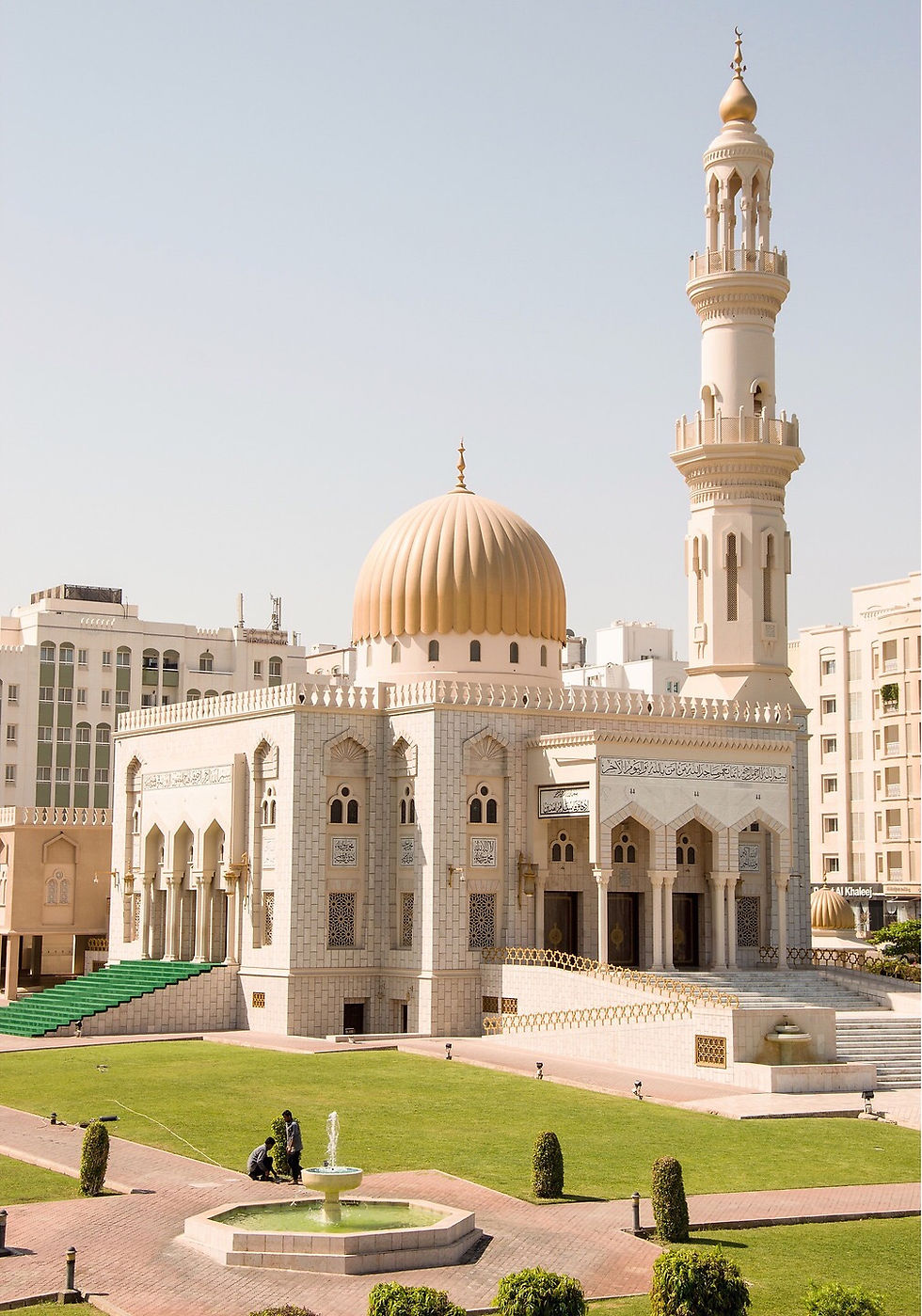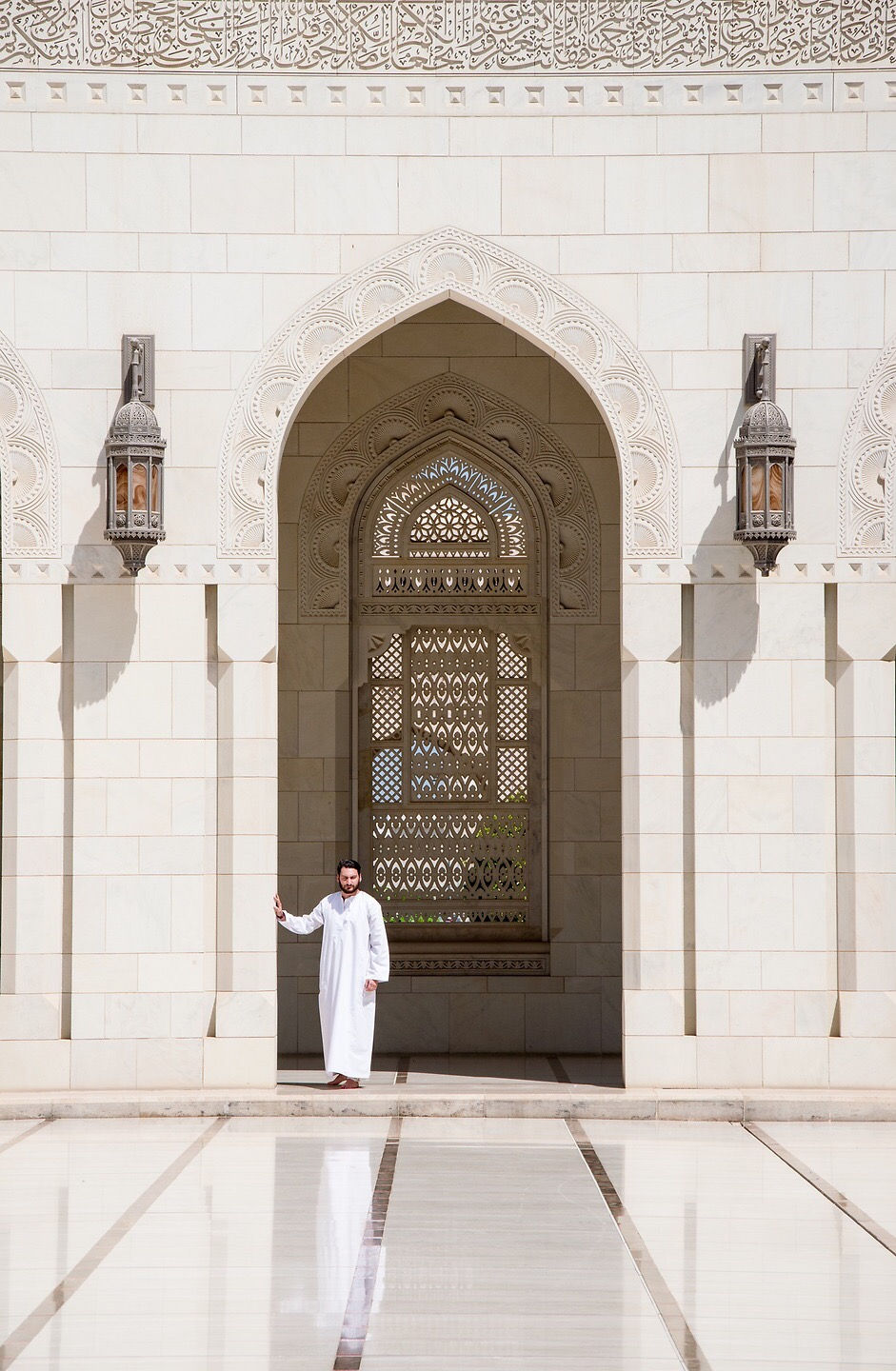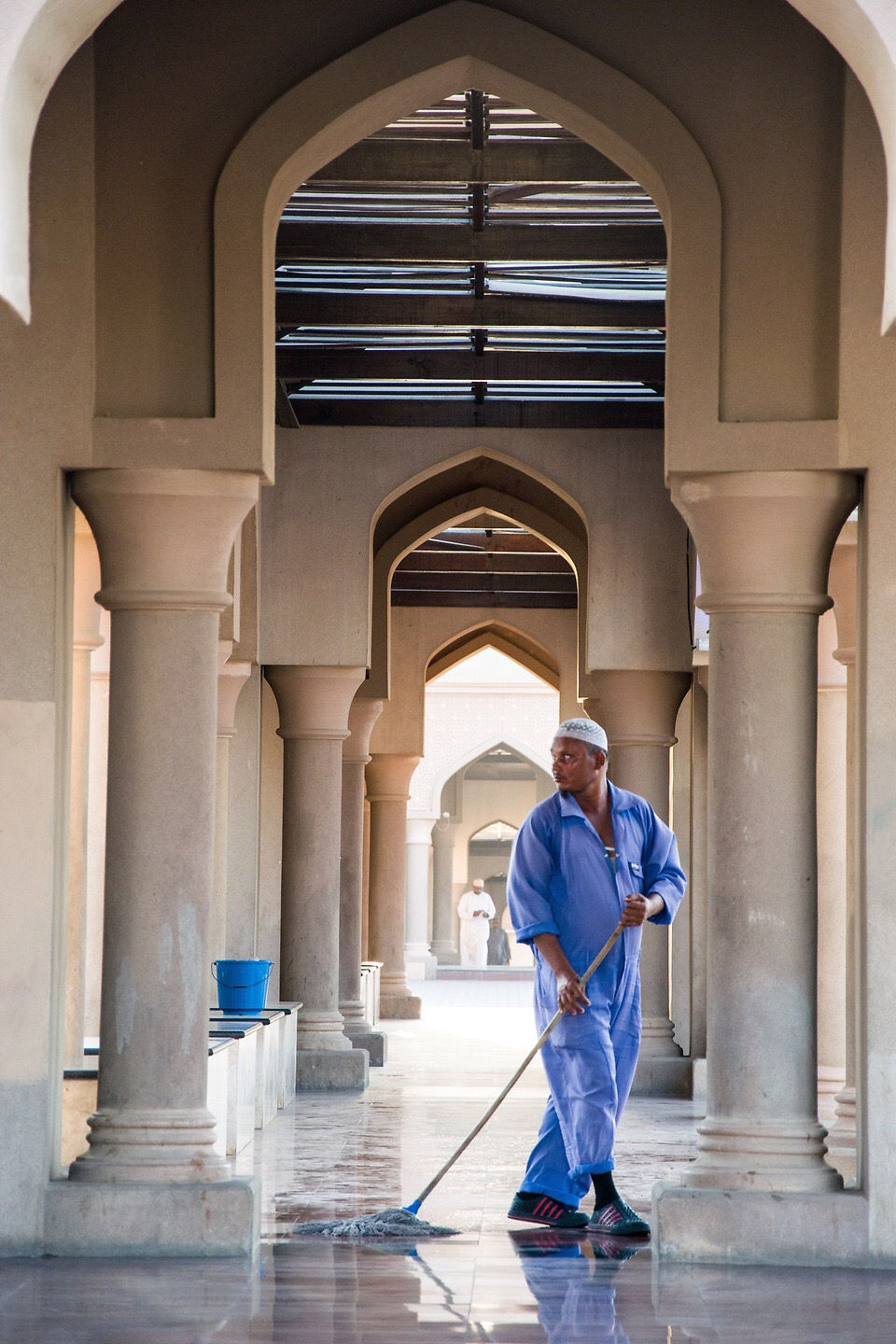Chapter 9 - Oman - Lost Enlightenment
- Sead Seferovic

- Apr 17, 2020
- 10 min read
Updated: Apr 18, 2020

In the cover of my series, a boy emerges as a silhouette through the archway in the Sultan Qaboos Mosque in Muscat, Oman. And it struck me then:
Not all those who wander are lost.
I first saw this sign late one night in Edinburgh - and it stayed with me forever. I was lost, metaphorically and literally when I came across this sign. And I understood then that I was not lost at all. That in the process of travel I had found my way and a purpose to my dreams. The only time that I ever lost my way was when I returned back home. The message says something profound. Though it is a quote from the popular fantasy book Lord of the Rings, it is a powerful metaphor of my personal journey.
The Sultan Qaboos mosque is the most serene and peaceful place in the world that I have ever been to. The gleaming white marble, the cleanliness, the spiritual calm. The open, radiant design. Being here was like a kind of spiritual cleansing. It was liberating and gave a sense of clarity of thought. I was overflowing with ideas for photography and followed a template several times of something I love doing - a candid shot of a silhouette emerging from a vertical archway of beautiful Islamic architecture. The enveloping white and cream of the buildings together with the black of the silhouettes created a natural form of black and white photography elements and allowed a high level of exposure to reflect the calm and serenity of the scenes that I was depicting.

Strange Journeys, Still Lives. This Kingdom of Peace is where I finally saw eudamonia - human flourishing, prosperity and happiness, as expressed by Aristotle. Oman was a silent enigma, a peaceful place of inner serenity. As I walked the gleaming white hallways of the Sultan Qaboos Mosque, I reflected that all that glitters is not gold. I was able to think clearly at what lay at the heart of all things, stillness, silence and balance. As-salamu alaykum - peace be upon you.

A Thousand Lives. Sometimes I feel like I have lived a thousand lives. I was born in Bosnia-Hercegovina and when I was eight years old I survived the war in my country. I was brought to the UK by my mother with my sister, where I spent most of my life. It seems like I have always been running from something. This sense of displacement fed my art and my desire to experience the world. The curiosity that powers a need for knowledge is a powerful thing, but not always a happy one. But in a thousand lives, the value of each is set out by Socrates: “The unexamined life is not worth living”.

I had to learn, had to experience a peaceful way of life, so I continued to explore the Sultan Qaboos Mosque. And then I saw the lady in the veil - I caught her fleeting movement under an archway in Oman. At that time I was reading a lot about Persian culture and Persian poetry, and although it is a different culture altogether to the Arab world, while walking here, this poem from Rumi spoke for itself, and spoke to me:
“Now listen to this reed-flute’s deep lament,
About the heartache being apart has meant,
‘Since from the reed-bed they uprooted me
My song’s expressed each human’s agony,
A breast which separation’s split in two
Is what I seek, to share this pain with you:
When kept from their origin, all yearn
For union on the day they can return.
The reed consoles those forced to be apart,
Its notes will lift the veil upon your heart,
Where’s antidote or poison like its song
Or confidant, or one who’s pined so long?
This reed relates a tortuous path ahead,
Recalls the love with which Manjoun’s heart bled:
The few who hear the truths the reed has sung
Have lost their wits so they can speak this tongue”.

The light in my dreams, I could always see it. It would sometimes fade to black, but the darkness was a void into which there would once again come a flood of brilliant white light.

Here in this mosque in Muscat, Oman, I walked along the marble hallways and as I set foot in the vast room of rich dark blue carpets and opulent, ornate chandeliers of a majestic and radiant presence, lines from the Persian poet Hafez came to me:
“Anything sweeter than the sound of love I haven’t heard.
Memorable echoes remain under this revolving dome”.

This place was my memoryhouse, a place where I was brought back to the innocence and wonder of my childhood. I knew this when I created a photographic work of the boy emerging as a silhouette from under the archway. And at this time, William Wordsworth spoke to me:
“My heart leaps up when I behold
A rainbow in the sky:
So was it when my life began;
So is it now I am a man;
So be it when I shall grow old,
Or let me die!
The Child is father of the Man;
And I could wish my days to be
Bound each to each by natural piety”.

I went back out into the heat of Oman, looking out through the eyes of a child. The heat was oppressive here in the Gulf, and in September the temperature had escalated far above 30 degrees Celsius. I could barely move, my head was faint and my entire body was zapped of energy, seeming to be drained of all its contents. Yet I kept on walking. Eventually I came to a serene mosque with a fountain of gushing, green water, emanating a fine spray of mist.

And it was near to this fountain, that the weary traveller sat down and laid down his hat.

That traveller was me, and as I sat in the shade of the fountain I thought once more of the words of Hafez:
“This love you now have of the Truth
Will never forsake you
Your joys and sufferings on this arduous path
Are lifting your worn veil like a rising stage curtain
And will surely reveal your Magnificent Self”.

The photograph One Wish was taken in a mosque somewhere in Muscat, in a place I can no longer remember. I was not supposed to be there taking photographs. I was approached by a man who demanded to know if I was a Muslim, confronting me with a direct “as-salaam aleikum”. Luckily I responded with “wa-alaikum-salaam”, and unto you be peace, and that averted any serious trouble you might think I could have gotten myself into. But I never cared for what anyone thought of me along my travels - I simply wanted to photograph my heart out.

Here in the Islamic world, I saw an Empire of the Mind - once again the Islamic peoples of the world would unite so that their culture could once again flourish. They would discover their Lost Enlightenment, and reignite the Golden Age of Islam, as described in the majestic book “Lost Enlightenment” by Frederick Starr, with scholars and artists preserving the knowledge of the ancient Greeks while around them in western Europe the dark ages descended, in warfare, death and pestilence - lives that were nasty, brutish and short. In the House of Wisdom in Baghdad, Islamic scholars preserved their dreams. Avicenna’s later advances in medicine. Al-Khwarazmi, who gave birth to algebra, and economic exchanges that have fuelled the western world itself.
This could happen again in the future, as the western world plunges into war, driven by the greed for money. It is the Islamic world that seeks to isolate itself and live co-operatively. The Islamic people have had many years longer on this earth, where they have been living together peacefully. Statistics show for example, how many wars were started by Iran from the 20th century to today, and the number is zero. The country of America has started wars continuously and aggressively, dominating countries and communities, assassinating leaders that majorities of people had voted for, killing and bloodshed on an unprecedented scale. All while America calls itself a democracy, which means that it allows its people to fight each other with little restriction and then fight other countries’ people without restriction. Why? So that Americans can make money from war.
War is a business. Having directly presented weapons to Saddam Hussein in Iraq, America later sought to demolish Iraq so that they could build infrastructure contracts with telecommunications operators, banks and other methods of taking money from innocent people and doing nothing to improve the lives of ordinary people. Deregulating the economy everywhere they turned, America demolished laws and social structures that were designed to help people in need to create a fairer, more peaceful world for all. The tactic of America has been proven to work throughout history - divide and conquer. Encourage your enemies to argue amongst themselves, create divisions, create different nationalities and turn the weak against each other. Fracture the Islamic world into thousands of pieces. And now, continuing to live in segregated nation states, there are Arab, Persian and Turk, and multitudes of other distinctions.

But in their heart of hearts, they should know that they are all brothers, and united they can stand up to brute force by setting an example of living in a harmonious, peaceful society, which they do in nearly all cases. As for terrorism, it is so rare that statistically the few instances of terrorism are far smaller than the massive amounts of lives lost in the terror of America’s wars against countries weaker than themselves in weapons and the angry need for money and power. People in western Asia should realise that Islam is their common bond, and use that common interest as a way to see the united humanity of them all, so that they may promote ethical and compassionate behaviour in the world, even if they may not observe religion literally, such as the case in today’s modern Turkey.
But it is the architects who impressed me most of all, their beautiful white designs shining with the serenity of an Islamic people who co-operate together and not compete against each other for idle and transient things. Islam builds, not destroys. Building brotherhood, ethical codes and strong communities, respect for the family. Islam is far more than a belief in god - it is an identity of a community of people and their shared culture. And that is why it still persists in the face of difficult odds.

Critics of the Islamic world often look to its lack of “progress”, against western criteria, such as individual freedom and economic development. It is a battle that the Islamic communities are bound to lose, since they are judged by the rules of the game at which the western world is proficient, and the Islamic world is handicapped in difficult geographical locations with scarcer resources. Yet these critics very rarely understand the things that the Islamic world does well. What do they suppose that the Islamic people have been doing for millions of years of their evolution?
The Islamic world has built tightly-knit structures of social relations and peaceful unification of people. This is explained more fully and clearly in the final chapter of this book, “The Science of Life”. It is obvious that co-operation poses an evolutionary advantage. This is particularly the case when there is a unification and homogenisation of similar peoples and/or other organic structures. Simply put, according to scientific principles, things that copy accurately and easily in simplified forms are mathematically more likely to exist, and hence there is more of them found in the universe’s physical laws.
And a large community of similarly minded people is a prime example of this evolutionary advantage, no matter what belief system they hold, for they have social structures and institutions that readily allow them to exist together on easier, more peaceful terms. In the west, there is an emphasis on individual competition, and the freeing of individuals from social or co-operative networks or structures, though there are always exceptions. And although sometimes individualistic sparks such as wars or competitive trade spark innovation that is for the later benefit of the whole group, an excess of individual competitiveness is often not an evolutionary advantage.

The western world of individualistic competition should learn from the Islamic world’s peaceful systems and social structures, to give it the balance that it is lacking, and to take account of the whole picture in evolutionary terms. Of course, the Islamic world is also conversely learning from individualistic competition and some of its benefits, because it is imposed on them by the west. Yet the Islamic or eastern systems of peaceful co-existence is non-confrontational in nature, and is not being imposed on the west. It ought to be understood better.
Both forms of structure, western emphasised individualistic competition, and Islamic emphasised social co-operation, as broad principles, could work together with greater integration and understanding. The cultures of west and east can and are being brought closer together, though there is a long way still to go. It is obvious even to a child that working together with others is more likely to ensure survival in the long term, no matter what the individual could achieve when freed from social obligations. It is a matter of simple statistics.
Of course, these are broad principles, with so many exceptions as to render the distinctions them completely blurred. Yet at this moment in time, the broad differences are still being highlighted by the sometimes confrontational behaviour between the east and west; and a greater pragmatism and holistic understanding of cultures would be in the evolutionary interests of all. It seems obvious to state this, yet in an age of confusion and mass-information, the quote by the ethically minded British intellectual George Orwell seems particularly apt, that “we have now sunk to a depth at which restatement of the obvious is the first duty of intelligent men.”

And of course, the artistic beauty that emanates from a socially and peacefully minded atmosphere in the Islamic world, is an evolutionary advantage in itself. The well-being and satisfaction of artistic or cultural fulfilment at times is not mere neurological cheesecake, as Professor Steven Pinker once famously and controversially wrote, as art and culture also drives progress and gives value to the lives of those who seek depth and beauty through their perceptions of the world, which is a persistent theme in this book, both through writing and photography.
Today, the youth of the Arab world have high hopes and dreams, in their own discovery of a new, integrated world.

In Muscat, Oman, a boy is captured emerging from a bus somewhere in the city. He is clutching his books and to me represents the hope, potential and dreams of the youth of the Arabic future. A key part of the Islamic faith is to continue one’s life-long process of education and understanding of the world. This is often a misunderstood aspect of Islam, or at least misunderstood by the western world, as with many other things. The title of the captured photograph is “High Hopes”, named directly after the song by Pink Floyd; and I come back to these lyrics time and again:
Beyond the horizon of the place we lived when we were young
In a world of magnets and miracles
Our thoughts strayed constantly and without boundary
The ringing of the division bell had begun
Along the Long Road and on down the Causeway
Do they still meet there by the Cut
There was a ragged band that followed in our footsteps
Running before time took our dreams away
Leaving the myriad small creatures trying to tie us to the ground
To a life consumed by slow decay
The grass was greener
The light was brighter
When friends surrounded
The nights of wonder
Looking beyond the embers of bridges glowing behind us
To a glimpse of how green it was on the other side
Steps taken forwards but sleepwalking back again
Dragged by the force of some inner tide
At a higher altitude the flag unfurled
We reached the dizzy heights of that dreamed of world
Encumbered forever by desire and ambition
There's a hunger still unsatisfied
Our weary eyes still stray to the horizon
Though down this road we've been so many times
The grass was greener
The light was brighter
The taste was sweeter
The nights of wonder
With friends surrounded
The dawn mist glowing
The water flowing
The endless river
Forever and ever





























Read on for the next chapter via the home page, as we are about to enter our journey together to - EGYPT......

















